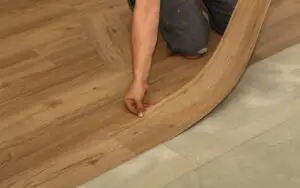Understanding the Basics: Buffing and Polishing
What is Floor Buffing?
Floor buffing is a maintenance process that uses a rotating pad to gently scrub the surface of a floor. The primary goal is to enhance shine, remove light scratches, and prepare the floor for additional treatments. Buffing doesn’t involve applying any new coatings; instead, it works with the existing finish to improve its appearance. While DIY buffing is common, achieving professional-level results often requires specialized equipment and expertise that only professional floor care services can provide.
What is Floor Polishing?
Floor polishing, on the other hand, involves applying a new coating or polish to the floor’s surface. This process not only enhances shine but also provides a protective layer against wear and tear. Polishing is typically more involved than buffing, requiring careful surface preparation and precise application techniques. The results are often more dramatic and long-lasting, but the process also requires more skill and experience.
Key Differences Between Buffing and Polishing
The key differences between buffing and polishing lie in their purpose and the materials used. Buffing is primarily a maintenance task that enhances existing shine, while polishing adds a new protective layer. Buffing uses a dry pad or a mild cleaning solution, while polishing involves applying a specialized coating. The choice between the two depends on the condition of the floor and the desired outcome, and professional floor care providers can help you determine the best approach.
Buffing: The Gentle Approach
When to Choose Buffing
Buffing is the ideal choice for floors that are in relatively good condition and simply need a shine boost. It’s also a great option for removing light scratches, scuffs, and minor imperfections. If your floors have lost their luster but don’t require a complete overhaul, buffing can be a quick and cost-effective solution. However, for floors with deeper damage or significant wear, polishing may be a better choice.
The Buffing Process
The buffing process typically involves cleaning the floor thoroughly to remove dirt and debris. Then, a specialized buffing machine with a soft pad is used to gently scrub the surface. The machine is moved in a consistent pattern to ensure even coverage. The process is relatively quick and doesn’t require any drying time. Professional floor buffing services ensure that the process is carried out efficiently and effectively, minimizing disruption to your daily routine.
Benefits of Floor Buffing
The benefits of floor buffing include enhanced shine, removal of light scratches, and a rejuvenated appearance. Buffing is also a relatively inexpensive and quick way to maintain the beauty of your floors. It’s a non-invasive process that doesn’t involve harsh chemicals or extensive labor. However, it’s important to note that buffing is not a substitute for polishing, and it won’t repair significant damage or restore floors with severely worn finishes.
Polishing: Achieving a High-Gloss Finish
When to Choose Polishing
Polishing is the preferred choice for floors that have lost their shine, have significant scratches or wear, or require a new protective layer. It’s also a great option for floors that need a complete makeover. If you’re looking for a dramatic transformation and long-lasting results, polishing is the way to go. Professional polishing services can assess the condition of your floors and recommend the best type of polish to achieve your desired outcome.
The Polishing Process
The polishing process is more involved than buffing and typically requires several steps. First, the floor must be thoroughly cleaned and any existing finishes removed. Then, a specialized polishing compound is applied to the surface. A polishing machine with a series of increasingly fine pads is used to smooth the surface and create a high-gloss finish. The process may require multiple coats of polish to achieve the desired level of shine and protection. Professional floor polishing services use advanced techniques and equipment to ensure a flawless and durable finish.
Benefits of Floor Polishing
The benefits of floor polishing include a high-gloss finish, enhanced durability, and protection against wear and tear. Polishing can also repair minor imperfections and restore the original beauty of your floors. It’s a long-lasting solution that can significantly extend the lifespan of your flooring. While the initial investment may be higher than buffing, the long-term benefits and enhanced appearance make it a worthwhile choice for many homeowners and businesses.
Equipment and Materials
Buffing Equipment
Buffing equipment typically consists of a floor buffer with a rotating pad. The pads are made of soft materials such as felt or lambswool and are designed to gently scrub the surface without causing damage. Buffers come in various sizes and power levels, and the right choice depends on the size and type of floor being buffed. Professional buffing services use high-quality equipment that is specifically designed for the task, ensuring optimal results.
Polishing Equipment
Polishing equipment is more specialized and typically includes a floor polisher with a series of increasingly fine pads. The polishes themselves are specialized chemical formulations designed to create a hard, durable, and reflective surface. These machines are more powerful and require more skill to operate than buffers. Professional polishing services invest in state-of-the-art equipment that can deliver a flawless finish on any type of flooring.
Choosing the Right Products
Choosing the right products is crucial for both buffing and polishing. For buffing, a mild cleaning solution or a specialized buffing compound may be used. For polishing, the choice of polish depends on the type of flooring and the desired level of shine and protection. It’s important to use products that are specifically designed for your flooring type to avoid damage or discoloration. Professional floor care providers have extensive knowledge of the various products available and can recommend the best options for your specific needs.
Floor Types and Suitable Treatments
Hardwood Floors
Hardwood floors are a classic choice that requires special care and attention. Buffing is a great option for maintaining the shine and removing light scratches on hardwood floors. Polishing may be necessary for floors that have lost their luster or have significant wear. It’s important to use products that are specifically designed for hardwood floors to avoid damage or discoloration. Professional hardwood floor care services can help you determine the best treatment for your floors and ensure that they receive the care they need to stay beautiful for years to come.
Tile Floors
Tile floors are durable and easy to maintain, but they can still benefit from buffing and polishing. Buffing can help remove dirt and grime from the surface, while polishing can restore the shine and protect against stains. It’s important to use products that are specifically designed for tile floors to avoid damaging the grout or the tile itself. Professional tile floor care services can help you choose the right treatments and ensure that your tile floors stay clean and shiny.
Concrete Floors
Concrete floors have become increasingly popular in both residential and commercial settings. Buffing can help remove dust and debris from the surface, while polishing can create a high-gloss finish that is both durable and aesthetically pleasing. Polishing concrete floors requires specialized equipment and techniques, and it’s best left to experienced professionals. Professional concrete floor care services can transform your concrete floors into a stunning and durable surface that will last for years to come.
DIY vs. Professional: Making the Right Choice
Assessing Your Skills and Experience
Before deciding whether to buff or polish your floors yourself, it’s important to honestly assess your skills and experience. Both buffing and polishing require a certain level of expertise and attention to detail to achieve satisfactory results. If you have limited experience with these types of projects, it may be best to leave it to the professionals. Professional floor care services have the knowledge, skills, and equipment to handle even the most challenging floor restoration projects.
Cost Analysis: DIY vs. Professional
A cost analysis of DIY versus professional floor care should consider the initial investment, ongoing maintenance, and potential for mistakes. DIY projects may seem cheaper initially, but the cost of equipment rental, supplies, and potential for errors can quickly add up. Professional floor care services may have a higher upfront cost, but they provide a long-lasting, durable finish that requires less frequent maintenance, potentially saving you money in the long run.
Risks of DIY Floor Care
DIY floor care projects carry several potential risks, including damage to the flooring, uneven application of finishes, and personal injury. Improper use of equipment, lack of experience, and failure to follow safety precautions can all lead to costly mistakes. Professional floor care services have the expertise, equipment, and insurance to mitigate these risks, ensuring a safe and successful outcome.
Potential Pitfalls of DIY Floor Care
Uneven Finishes
One of the most common pitfalls of DIY floor care is achieving an uneven finish. This can be caused by improper application techniques, using the wrong products, or failing to properly prepare the surface. Uneven finishes can detract from the appearance of your floors and may require costly repairs. Professional floor care providers have the expertise to avoid these pitfalls and ensure a smooth, even finish.
Damage to the Floor Surface
Another potential pitfall of DIY floor care is damage to the floor surface. Using abrasive cleaners, improper equipment, or excessive pressure can scratch, gouge, or otherwise damage your floors. Professional floor care providers have the knowledge and experience to protect your floors from damage and ensure a safe and successful outcome.
Safety Concerns
DIY floor care can also pose safety concerns, such as exposure to hazardous chemicals, slips and falls, and electrical hazards. It’s important to follow safety precautions and use appropriate protective gear to minimize these risks. Professional floor care providers are trained in safety procedures and use specialized equipment to minimize the risk of accidents and injuries.
The Benefits of Professional Floor Care
Expertise and Experience
One of the primary benefits of hiring a professional floor care provider is their expertise and experience. They have the knowledge and skills to assess the condition of your floors, recommend the appropriate treatment, and execute the work flawlessly. This expertise can save you time, money, and frustration in the long run.
Advanced Techniques
Professional floor care providers use advanced techniques and equipment to achieve superior results. They stay up-to-date on the latest industry trends and best practices and invest in state-of-the-art technology to deliver exceptional service. This commitment to excellence ensures that your floors receive the best possible care and attention.
Guaranteed Results
Professional floor care providers typically offer guaranteed results and customer satisfaction. They stand behind their work and will take the necessary steps to ensure that you are completely happy with the outcome. This peace of mind is invaluable and can justify the cost of hiring a professional.
Maintaining Your Floors After Buffing or Polishing
Regular Cleaning
Regular cleaning is essential for maintaining the beauty and longevity of your floors after buffing or polishing. Sweeping or vacuuming should be done regularly to remove dirt, dust, and debris. Mopping with a neutral pH cleaner can help remove stains and spills without damaging the finish. Avoiding the use of harsh chemicals and abrasive cleaners is crucial for protecting the surface.
Protecting the Finish
Protecting the finish is key to prolonging the life of your buffed or polished floors. Use mats and rugs in high-traffic areas to minimize wear and tear. Avoid dragging furniture across the floor, and use felt pads under furniture legs to prevent scratches. Promptly clean up spills to prevent staining and damage to the finish.
Preventing Scratches and Scuffs
Preventing scratches and scuffs is essential for maintaining the appearance of your floors. Encourage residents or employees to remove their shoes before entering the building. Place mats at entryways to trap dirt and debris. Avoid wearing shoes with hard soles or high heels on your floors.
Case Studies: Buffing and Polishing Success Stories
Residential Homes
Many residential homeowners have experienced the benefits of professional floor buffing and polishing services. For example, a homeowner with scratched and dull hardwood floors hired a professional to buff and polish the floors. The result was a dramatically improved appearance and a renewed sense of pride in their home. The floors looked brand new, and the homeowner was thrilled with the outcome.
Commercial Spaces
Commercial spaces also benefit greatly from professional floor buffing and polishing services. For example, a retail store with high-traffic tile floors hired a professional to regularly buff and polish the floors. The result was a cleaner, more attractive store that customers enjoyed shopping in. The improved appearance of the floors also helped to enhance the store’s brand image and attract new customers.
Long-Term Results
The long-term results of professional floor buffing and polishing services are consistently positive. Customers report that their floors look better, last longer, and require less maintenance after undergoing professional treatment. These benefits make professional floor care a worthwhile investment for both residential and commercial properties.
FAQs & Answers
While the equipment used for buffing and polishing may look similar, they serve distinct purposes and often require different pads and settings. Buffing typically involves a lighter touch, using softer pads to remove surface dirt and enhance shine. Polishing, on the other hand, requires specialized equipment and polishing compounds to create a protective layer and a high-gloss finish. Professional services understand these nuances and utilize the appropriate equipment and techniques for each task, ensuring optimal results and preventing damage to your floors. Therefore, attempting to use the same equipment for both processes without proper knowledge can lead to unsatisfactory outcomes and potential harm to your flooring.
The frequency of buffing or polishing your floors depends on several factors, including the type of flooring, the amount of foot traffic, and your desired level of shine. High-traffic areas may require more frequent buffing or polishing to maintain their appearance. Regular buffing can help remove surface dirt and scratches, while polishing is typically reserved for restoring a dull finish or adding a protective layer. Professional floor care services can assess your specific needs and recommend a maintenance schedule that keeps your floors looking their best without overdoing it. Their expertise ensures your floors receive the right amount of attention to maintain their beauty and longevity.
Generally, buffing is less expensive than polishing due to its simpler process and lower material costs. Buffing is primarily a maintenance task, while polishing involves applying a new coating, which requires more time, specialized equipment, and higher-cost materials. However, the cost-effectiveness of each option also depends on the condition of your floors. If your floors only need a shine boost, buffing is a cost-effective solution. But if your floors are heavily damaged or require a new protective layer, polishing may be the more cost-effective option in the long run. Professional floor care services can provide a detailed cost analysis based on your specific needs and budget, helping you make an informed decision.
Floors that benefit most from buffing are those with a relatively intact finish that simply needs a shine boost. Hardwood floors, tile floors, and linoleum floors can all benefit from regular buffing. The process removes surface dirt and scratches, enhancing the floor's appearance without the need for a complete refinishing. However, floors with significant damage, such as deep scratches or a worn-out finish, may require polishing or other more intensive treatments. Professional assessment can determine if buffing is the appropriate solution for your floors.
Floors that benefit most from polishing are those that have lost their shine, have significant scratches or wear, or require a new protective layer. Concrete floors, hardwood floors, and tile floors can all benefit from polishing. The process restores the floor's appearance and provides a durable, long-lasting finish. Polishing is also a great option for floors that are subjected to high traffic or heavy use. Professional floor care services have the expertise and equipment to polish a wide variety of floor types, ensuring a beautiful and durable result.





